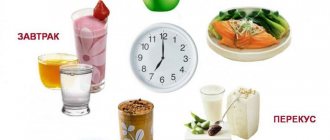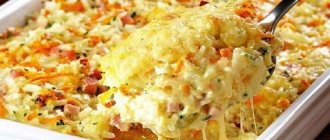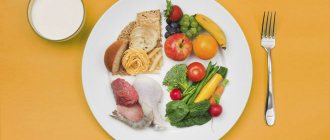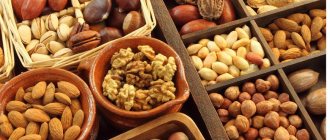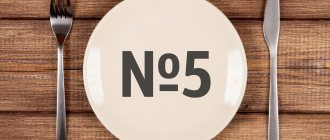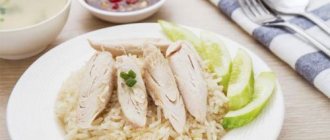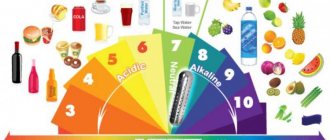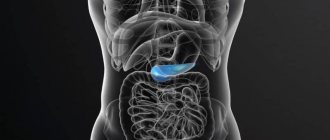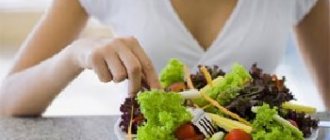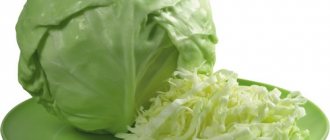Pancreatic necrosis is the cessation of functionality, otherwise death, of pancreatic cells. The process is irreversible and is a consequence of chronic or acute inflammation of the gland (pancreatitis). To eliminate the pathology, an operation is necessary - necrectomy of the pancreas. After surgery, treatment is based on taking medications and strict adherence to a diet.
According to therapeutic nutrition according to V. Pevzner, the diet for pancreatic necrosis in the postoperative period includes “table No. 0” and “table No. 5P”. Diet therapy is aimed at reducing congestion, inhibiting pancreatic hyperenzymemia (increased enzyme production) and maximizing unloading of the pancreas (mechanical, thermal and chemical sparing).
Reference! Mechanical sparing involves grinding food, chemical sparing involves eliminating foods that irritate the damaged organ from the diet and proper cooking of foods, thermal sparing involves maintaining the temperature of food.
General rules
Pancreatic necrosis is one of the forms of acute/chronic pancreatitis , which is characterized by pronounced destructive processes in the pancreatic tissue. There are:
- aseptic uncomplicated pancreatic necrosis (acute necrotic);
- aseptic complicated small-focal pancreatic necrosis (infiltrative-necrotic);
- infected large-focal pancreatic necrosis (purulent-necrotic).
Destructive forms of pancreatitis are the most complex forms of the disease and develop in 30-35% of patients with inflammation of the pancreas. Of particular danger is infected necrosis of the pancreas, which is a substrate for the development of severe purulent complications ( phlegmon of the retroperitoneum, pancreatogenic abscess , purulent peritonitis ). Mortality in complicated forms of pancreatic necrosis reaches 25-40%. Infection of foci of pancreatic necrosis is caused mainly by translocation of intestinal microflora and is most often polymicrobial ( Escherichia coli , Klebsiella, Enterobacteriaceae, Proteus, Enterococci).
Therapeutic tactics are determined primarily by the form of the disease. Thus, if in the acute necrotic/infiltrative-necrotic form the leading importance is given to conservative therapy and to a much lesser extent to surgical intervention, then in the purulent-necrotic form the main approach to treatment is surgery. Properly organized nutrition for pancreatic necrosis is an integral and most important component of conservative therapy.
The diet for pancreatic necrosis of the pancreas is based on the treatment Table No. 5P (its variants) and is based on sparing the pancreas from various negative impact factors, reducing the reflex excitability of the gallbladder and stasis in the bile ducts/duodenum, and excluding stimulants of pancreatic secretion. Medical nutrition is considered as the most important link in the pharmacotherapy of metabolic disorders and is the basis for high-quality provision of the energy/plastic needs of the patient’s body.
The modern concept of nutritional support for a patient with pancreatic necrosis has abandoned the concept of a long-term (2-3 day) “starvation” diet. It has been reliably established that fasting causes the development of hypodysproteinemia , metabolic acidosis , accelerates the development of lipolysis , and aggravates degenerative changes in the gland. Therefore, the duration of the fasting diet should not exceed one day (and in severe cases it should be abandoned altogether) with the patient immediately transferred to parenteral nutrition using concentrated solutions of amino acids , glucose and fat emulsions ( Intralipid 10-20%, Lipovenosis ), and in further - a gradual transfer to enteral/mixed nutrition and the gradual introduction of products from the diet of the 5P Diet of the first version.
It has been established that early parenteral/enteral nutrition helps accelerate reparative processes in the pancreas and gastrointestinal tract as a whole. The algorithm, stages and duration of nutritional support in one form or another (parenteral/enteral/mixed and dietary nutrition itself) are determined by the form of pancreatic necrosis, the patient’s condition and the presence of complications.
The stage of transferring the patient directly to dietary nutrition should be gradual. In the first 4-5 days, mineral non-carbonated alkaline water (Essentuki No. 17, Borjomi), rosehip decoction, weak tea in small portions are introduced into the diet and a low-calorie diet is prescribed, the diet of which contains 60 g of proteins and no more than 50 g of fat.
The diet contains boiled foods with a semi-liquid consistency, and only on the 5th-6th day the food is prepared in a semi-viscous consistency. The basis of the diet is carbohydrate foods, since they stimulate the secretory function of the pancreas to a lesser extent. On the first/second day the following are allowed:
- decoctions of cereals (except for millet/corn grits) or slimy unsalted soups;
- vegetable decoctions;
- stale white bread/crackers;
- liquid, well-mashed porridge;
- pureed compotes/jelly and jelly from fruit juice with a sweetener ( xylitol );
- weak green tea with sugar.
On the third day, foods containing protein are gradually added to the diet to carbohydrate foods: steamed omelet from 1-2 eggs per day, non-acidic curd paste/pudding. On the 4th day - boiled meat soup, porridge with milk. From 6-7 days, the diet is expanded by adding pureed vegetable soups (except cabbage), butter, carrot, beet or potato puree, fish/meat soufflé, and after another 3-4 days - steamed cutlets from chicken, beef, turkey, fish (skin, fat and tendons are removed).
Meals are fractional (up to 8 times) and in portions of no more than 250 g, starting from 50-100 g. As symptoms subside (pain decreases/digestion improves), the patient is transferred to the second version of the diet, the energy value of which is increased to 1600 kcal/day with containing 70-80 g of protein, 50 g of fat and 200-250 g of carbohydrates, of which 15 g are sugar, 5-6 g of table salt.
The volume of free liquid is 1.5-2. The food is cooked boiled/steamed, pureed, and later simply chopped thoroughly. Similar approaches to dietary nutrition are also practiced after surgery for pancreatic necrosis.
It should be borne in mind that the duration of treatment on nutritional therapy must be at least one year, and in some cases it must be observed for life. The Basic Table 5P is a physiologically complete diet with a protein content of 110-120 g, fat - the lower limit of normal (70-80 g / day) and a slight restriction of carbohydrates, mainly due to simple carbohydrates. Exclusion from the diet of extractives and coarse fiber is provided.
For this purpose, the meat is cooked several times in small pieces, periodically draining the water. Then the meat boiled in this way is used to prepare various dishes. The diet widely uses foods that have the ability to inhibit proteolytic enzymes: egg whites, potatoes, oatmeal, soybeans.
Refractory fats of animal origin are excluded, since patients often have steatorrhea (the presence of fats in the stool), therefore it is advisable to introduce refined/unrefined vegetable oils into the diet.
It is not allowed to consume foods with a pronounced juice effect: meat/fish/bone and mushroom broths, fried foods. It is strictly prohibited to consume alcohol-containing drinks that have a pronounced stimulation of pancreatic secretion.
During the period of remission, the diet is expanded to include vegetables/fruits, which can also be consumed raw as part of vinaigrettes, salads or side dishes. In addition to cereals, you are allowed to eat pasta, cereals, and pilaf with boiled meat. Soups are prepared mostly without puree and gradually introduce borscht, beetroot soup, and cabbage soup. It is allowed to use homemade spices and sauces in small quantities.
During the remission stage, it is recommended to take warm, non-carbonated low- to medium-mineralized mineral waters for a month. Meals remain fractional (up to 6 times a day), without overeating. If there are concomitant diseases ( cholecystitis , gastritis ), the diet is adjusted.
Dietary vinaigrette
Some salads are also not prohibited for pancreatic necrosis. So a vinaigrette can be quite useful. To prepare it, you need to leave two hundred and fifty grams of sauerkraut and one pickled cucumber in water for half an hour in advance. Then cook two medium-sized potatoes and one beet in their skins until tender.
Next, all that remains is to cut all the components into equal cubes, mix and season with a small amount of vegetable oil. The second salad approved by nutritionists is beet salad. Two or three beets are boiled in their skins until fully cooked, after which they are grated or finely chopped, salted and flavored with vegetable or olive oil.
Authorized Products
The diet for pancreatic necrosis of the pancreas includes:
- Vegetable broths or soups (puree soups) based on them, into which pureed vegetables and well-cooked and ground cereals are added. Soups can be seasoned with cream, butter, sour cream.
- Low-fat varieties of beef/veal, rabbit, chicken in the form of minced products - cutlets, steamed meatballs.
- Oatmeal, buckwheat, white rice, cooked in water, ground and brought to a semi-viscous consistency by adding milk or water.
- Stale/yesterday wheat bread, biscuits.
- Vegetables (boiled / pureed - zucchini, carrots, potatoes, pumpkin, cauliflower, beets, green peas). At the remission stage, it is allowed to eat grated cucumbers and peeled tomatoes, raw grated carrots and pumpkin.
- Low-fat varieties of sea/river fish (carp, pike perch, hake, cod, pollock, pike, perch), steamed in the form of cutlets or boiled in pieces.
- Low-fat dairy/fermented milk products and calcined cottage cheese in the form of casseroles and puddings. Milk is only allowed to be added to ready-made dishes, as it is poorly tolerated. Sour cream and mild cheese, grated, as a seasoning for dishes.
- Steamed egg white omelettes (1 egg per day).
- Homemade sauces based on vegetable broth with the addition of cream/sour cream.
- Sweet baked blocks, pureed dried fruits and fruits in the form of marshmallows, jelly, mousse. Raw, thoroughly ground fruits/berries are allowed to a limited extent.
- Fats include butter and refined vegetable oils.
Table of permitted products
| Proteins, g | Fats, g | Carbohydrates, g | Calories, kcal | |
Vegetables and greens | ||||
| zucchini | 0,6 | 0,3 | 4,6 | 24 |
| broccoli | 3,0 | 0,4 | 5,2 | 28 |
| cauliflower | 2,5 | 0,3 | 5,4 | 30 |
| potato | 2,0 | 0,4 | 18,1 | 80 |
| carrot | 1,3 | 0,1 | 6,9 | 32 |
| cucumbers | 0,8 | 0,1 | 2,8 | 15 |
| tomatoes | 0,6 | 0,2 | 4,2 | 20 |
| pumpkin | 1,3 | 0,3 | 7,7 | 28 |
Fruits | ||||
| apples | 0,4 | 0,4 | 9,8 | 47 |
Nuts and dried fruits | ||||
| dried apricots | 5,2 | 0,3 | 51,0 | 215 |
| dried apricots | 5,0 | 0,4 | 50,6 | 213 |
| prunes | 2,3 | 0,7 | 57,5 | 231 |
Cereals and porridges | ||||
| buckwheat (kernel) | 12,6 | 3,3 | 62,1 | 313 |
| semolina | 10,3 | 1,0 | 73,3 | 328 |
| oat groats | 12,3 | 6,1 | 59,5 | 342 |
| rice | 6,7 | 0,7 | 78,9 | 344 |
Bakery products | ||||
| wheat bread | 8,1 | 1,0 | 48,8 | 242 |
Confectionery | ||||
| jam | 0,3 | 0,2 | 63,0 | 263 |
| jelly | 2,7 | 0,0 | 17,9 | 79 |
| marshmallows | 0,8 | 0,0 | 78,5 | 304 |
| fruit and berry marmalade | 0,4 | 0,0 | 76,6 | 293 |
| paste | 0,5 | 0,0 | 80,8 | 310 |
| Maria cookies | 8,7 | 8,8 | 70,9 | 400 |
Raw materials and seasonings | ||||
| honey | 0,8 | 0,0 | 81,5 | 329 |
| sugar | 0,0 | 0,0 | 99,7 | 398 |
Dairy | ||||
| kefir 1.5% | 3,3 | 1,5 | 3,6 | 41 |
| curdled milk 1% | 3,0 | 1,0 | 4,1 | 40 |
| acidophilus 1% | 3,0 | 1,0 | 4,0 | 40 |
Cheeses and cottage cheese | ||||
| cottage cheese 1% | 16,3 | 1,0 | 1,3 | 79 |
| cottage cheese 1.8% (low-fat) | 18,0 | 1,8 | 3,3 | 101 |
Meat products | ||||
| beef | 18,9 | 19,4 | 0,0 | 187 |
| rabbit | 21,0 | 8,0 | 0,0 | 156 |
Bird | ||||
| boiled chicken breast | 29,8 | 1,8 | 0,5 | 137 |
| boiled turkey fillet | 25,0 | 1,0 | — | 130 |
Eggs | ||||
| chicken eggs | 12,7 | 10,9 | 0,7 | 157 |
Fish and seafood | ||||
| flounder | 16,5 | 1,8 | 0,0 | 83 |
| pollock | 15,9 | 0,9 | 0,0 | 72 |
| blue whiting | 16,1 | 0,9 | — | 72 |
| cod | 17,7 | 0,7 | — | 78 |
| hake | 16,6 | 2,2 | 0,0 | 86 |
| pike | 18,4 | 0,8 | — | 82 |
Oils and fats | ||||
| butter | 0,5 | 82,5 | 0,8 | 748 |
| sunflower oil | 0,0 | 99,9 | 0,0 | 899 |
Non-alcoholic drinks | ||||
| water | 0,0 | 0,0 | 0,0 | — |
| mineral water | 0,0 | 0,0 | 0,0 | — |
Juices and compotes | ||||
| apricot juice | 0,9 | 0,1 | 9,0 | 38 |
| carrot juice | 1,1 | 0,1 | 6,4 | 28 |
| peach juice | 0,9 | 0,1 | 9,5 | 40 |
| pumpkin juice | 0,0 | 0,0 | 9,0 | 38 |
| rose hip juice | 0,1 | 0,0 | 17,6 | 70 |
| * data is per 100 g of product | ||||
Cooking options
Dishes are prepared only from approved products. When using recipes, you should pay attention that the food is not flavored with sauces, spices and butter.
Chicken soufflé
Required:
- two chicken breast fillets;
- 200 ml 1.5% milk;
- two eggs;
- a little salt and butter.
In eggs, separate the white from the yolk. Cut the chicken meat and grind it in a food processor or meat grinder. Mix the minced meat, milk and yolks, add a little salt and puree with a blender. Beat the remaining whites with a mixer and carefully fold into the minced meat using a wooden or silicone spatula. Grease muffin tins with butter and distribute the resulting meat mass into them. Place in the oven, preheated to 180°C for a quarter of an hour.
To ensure a fluffy soufflé, do not open the oven during cooking.
Baked flounder or chicken
The recipes are similar in the method of cooking in a slow cooker. Cooking time – 105 minutes, mode – “baking”, temperature – 145° C. Wash the fish, cut off the tail and head. Remove the innards, cut off the fins with scissors, and rinse again. Dry with a paper towel, cut into portions, and season with salt. Wrap each piece in a separate sheet of foil. Place in a slow cooker. Marinate the chicken fillet for 20–30 minutes in soy sauce (1 tbsp) and vegetable oil (1 tbsp). Wrap tightly in foil and place in the slow cooker.
Puff salad
Required components:
- carrots – 1 pc.;
- chicken fillet – 1 pc.;
- potatoes – 1–2 pcs.;
- eggs – 2 pcs.;
- Ricotta cheese;
- natural yoghurt 2.5%.
Boil chicken breast, carrots, potatoes, eggs. Pass the boiled fillet through a meat grinder, mix with Ricotta and puree with a blender. Grate potatoes and carrots on a fine grater, egg whites on a coarse grater. Assemble the salad in layers: potatoes – chicken fillet with cheese – egg whites – carrots. Lightly salt each layer (including the top one) and brush with yogurt. Leave for 1–1.5 hours until the layers are well saturated.
Fully or partially limited products
Dietary nutrition for pancreatic necrosis of the pancreas involves exclusion from the diet:
- Soups with meat/mushroom/fish broth, okroshka, borscht, beetroot soup, cabbage soup.
- Cooking/animal fats, seasonings/spices (ketchup, horseradish, mayonnaise, herbs, mustard, pepper).
- Fried/hard-boiled eggs, full-fat milk, salty spicy cheese, cream, high-fat cottage cheese with high acidity, condensed milk.
- Fatty varieties of red meat/fish, goose and duck meat, smoked meats, any fried foods, fish caviar, canned food, salted fish, sausages, offal.
- Vegetables containing coarse fiber (radish, turnip, rutabaga, white cabbage, radish, eggplant), mushrooms, legumes.
- Rye/fresh wheat bread, puff pastry, pastries with cream, pancakes, cakes, yeast baked goods, cheesecakes and pancakes, fried pies.
- Some types of porridges (barley, millet, pearl barley, corn).
- Fruits containing simple carbohydrates (dates, bananas, grapes). Raw vegetables/fruits - limited with caution.
- Chocolate, ice cream, jam, black/green strong coffee, honey, grape juice, carbonated/alcoholic drinks, cocoa.
Table of prohibited products
| Proteins, g | Fats, g | Carbohydrates, g | Calories, kcal | |
Vegetables and greens | ||||
| canned vegetables | 1,5 | 0,2 | 5,5 | 30 |
| eggplant | 1,2 | 0,1 | 4,5 | 24 |
| swede | 1,2 | 0,1 | 7,7 | 37 |
| peas | 6,0 | 0,0 | 9,0 | 60 |
| cabbage | 1,8 | 0,1 | 4,7 | 27 |
| bulb onions | 1,4 | 0,0 | 10,4 | 41 |
| chickpeas | 19,0 | 6,0 | 61,0 | 364 |
| salad pepper | 1,3 | 0,0 | 5,3 | 27 |
| parsley | 3,7 | 0,4 | 7,6 | 47 |
| radish | 1,2 | 0,1 | 3,4 | 19 |
| white radish | 1,4 | 0,0 | 4,1 | 21 |
| dill | 2,5 | 0,5 | 6,3 | 38 |
| beans | 7,8 | 0,5 | 21,5 | 123 |
| horseradish | 3,2 | 0,4 | 10,5 | 56 |
| spinach | 2,9 | 0,3 | 2,0 | 22 |
| sorrel | 1,5 | 0,3 | 2,9 | 19 |
Fruits | ||||
| bananas | 1,5 | 0,2 | 21,8 | 95 |
Berries | ||||
| grape | 0,6 | 0,2 | 16,8 | 65 |
Mushrooms | ||||
| mushrooms | 3,5 | 2,0 | 2,5 | 30 |
| marinated mushrooms | 2,2 | 0,4 | 0,0 | 20 |
Nuts and dried fruits | ||||
| nuts | 15,0 | 40,0 | 20,0 | 500 |
| raisin | 2,9 | 0,6 | 66,0 | 264 |
| seeds | 22,6 | 49,4 | 4,1 | 567 |
| dates | 2,5 | 0,5 | 69,2 | 274 |
Cereals and porridges | ||||
| corn grits | 8,3 | 1,2 | 75,0 | 337 |
| millet cereal | 11,5 | 3,3 | 69,3 | 348 |
| barley grits | 10,4 | 1,3 | 66,3 | 324 |
Flour and pasta | ||||
| pasta | 10,4 | 1,1 | 69,7 | 337 |
| dumplings | 11,9 | 12,4 | 29,0 | 275 |
Bakery products | ||||
| buns | 7,9 | 9,4 | 55,5 | 339 |
| Rye bread | 6,6 | 1,2 | 34,2 | 165 |
Confectionery | ||||
| pastry cream | 0,2 | 26,0 | 16,5 | 300 |
| shortbread dough | 6,5 | 21,6 | 49,9 | 403 |
Ice cream | ||||
| ice cream | 3,7 | 6,9 | 22,1 | 189 |
Chocolate | ||||
| chocolate | 5,4 | 35,3 | 56,5 | 544 |
Raw materials and seasonings | ||||
| mustard | 5,7 | 6,4 | 22,0 | 162 |
| mayonnaise | 2,4 | 67,0 | 3,9 | 627 |
Dairy | ||||
| milk 4.5% | 3,1 | 4,5 | 4,7 | 72 |
| cream 35% (fat) | 2,5 | 35,0 | 3,0 | 337 |
| whipped cream | 3,2 | 22,2 | 12,5 | 257 |
| sour cream 30% | 2,4 | 30,0 | 3,1 | 294 |
Cheeses and cottage cheese | ||||
| parmesan cheese | 33,0 | 28,0 | 0,0 | 392 |
Meat products | ||||
| fatty pork | 11,4 | 49,3 | 0,0 | 489 |
| salo | 2,4 | 89,0 | 0,0 | 797 |
| bacon | 23,0 | 45,0 | 0,0 | 500 |
Sausages | ||||
| smoked sausage | 9,9 | 63,2 | 0,3 | 608 |
Bird | ||||
| smoked chicken | 27,5 | 8,2 | 0,0 | 184 |
| duck | 16,5 | 61,2 | 0,0 | 346 |
| smoked duck | 19,0 | 28,4 | 0,0 | 337 |
| goose | 16,1 | 33,3 | 0,0 | 364 |
Fish and seafood | ||||
| smoked fish | 26,8 | 9,9 | 0,0 | 196 |
| black caviar | 28,0 | 9,7 | 0,0 | 203 |
| salmon caviar granular | 32,0 | 15,0 | 0,0 | 263 |
| salmon | 19,8 | 6,3 | 0,0 | 142 |
| canned fish | 17,5 | 2,0 | 0,0 | 88 |
| salmon | 21,6 | 6,0 | — | 140 |
| trout | 19,2 | 2,1 | — | 97 |
Oils and fats | ||||
| animal fat | 0,0 | 99,7 | 0,0 | 897 |
| cooking fat | 0,0 | 99,7 | 0,0 | 897 |
Alcoholic drinks | ||||
| dry red wine | 0,2 | 0,0 | 0,3 | 68 |
| vodka | 0,0 | 0,0 | 0,1 | 235 |
| beer | 0,3 | 0,0 | 4,6 | 42 |
Non-alcoholic drinks | ||||
| soda water | 0,0 | 0,0 | 0,0 | — |
| cola | 0,0 | 0,0 | 10,4 | 42 |
| instant coffee dry | 15,0 | 3,5 | 0,0 | 94 |
| sprite | 0,1 | 0,0 | 7,0 | 29 |
Juices and compotes | ||||
| grape juice | 0,3 | 0,0 | 14,0 | 54 |
| * data is per 100 g of product | ||||
What not to eat if you have pancreatitis
Many foods can cause increased secretion of acid and enzymes, which greatly irritate the pancreatic mucosa.
Therefore, it is better to remove all harmful foods from your diet:
- spicy, sour, fried foods, canned food and pickles, fatty meat broths (in particular jellied meat);
- seasonings, spices, sauces, mayonnaise, ketchup;
- meat and its by-products - pork (pork tongue), lamb, including fat, sausages, smoked meats, frankfurters, balyki, lard;
- fatty fish (salmon, catfish, carp, mackerel, herring) and seafood (mussels, squid, crabs, lobsters);
- rich pastries, rye bread, chocolate products, cakes, sweets (lollipops, caramel), halva, ice cream, glazed cheese curds;
- oranges, figs, sunflower seeds, radishes, radishes, all types of mushrooms.
It is contraindicated to drink coffee, strong black and green tea, milk, and carbonated drinks. The following prohibited foods should be permanently excluded from everyday consumption: fast food (burgers, fries, shawarma, hot dogs, sushi, rolls), chips, salted nuts, hot spices, alcohol, nicotine.
Advantages and disadvantages
| pros | Minuses |
|
|
Cream of broccoli soup
The most popular and useful recipes from the diet after pancreatic necrosis are the first courses. A special place among them is occupied by cream of broccoli soup. To prepare cream soup correctly, first you need to bring half a liter of water to a boil, throw two or three peeled potatoes and about five broccoli florets into it.
Cook vegetables for about twenty minutes over medium heat. Next, pour the broth into a separate container, and grind the potatoes and broccoli in a blender to a puree consistency. Next, dilute the resulting puree with previously drained broth, return to the stove and cook until thickened.
Reviews and results
A diet for pancreatic necrosis of the pancreas requires careful adherence to it and avoidance of errors in eating. According to patient reviews, adherence to therapeutic nutrition allows one to stop/reduce the clinical symptoms of the disease. In reviews, many patients write about the need to adapt to individual nutrition, since this diet must be followed almost for life.
- “... I was admitted to the hospital with a diagnosis: sterile hemorrhagic widespread pancreatic necrosis, aseptic phlegmon on the left (pericolic tissue), pancreatogenic peritonitis. Severity - on the APACHE II scale - 10 points. They operated on him immediately. I was in intensive care for almost 5 days, then transferred to the department. I ate nothing for almost a week, they injected everything into a vein, and then switched to special mixtures. Now I eat little by little, my diet is strict. My wife was told that if I pulled through, I would have to go on a diet for the rest of my life. Yes, I don’t mind, as long as I stay alive, because I’m only 54 years old”;
- “... I have chronic pancreatitis. I watch my diet very strictly. Doctors warned of a serious risk of complications, in particular pancreatic necrosis. I studied in detail all diet options, nutritional principles, allowed/prohibited foods. I purchased everything I needed for cooking - a high-quality steamer, and studied the specifics of preparing dietary dishes. So far I feel fine and, although steamed and mashed food has already set my teeth on edge, I understand that this is my destiny for the rest of my life, so I try not to dwell on the negative.”
Diet recipes
It is important to remember that it is quite possible to eat tasty and healthy food in case of this disease. However, it is worth remembering some rules when preparing dishes, namely:
- Salt and sugar should be added in minimal quantities.
- All food preparations must be thoroughly washed.
- You should carefully study the composition of products before purchasing. Preference should be given only to natural ingredients.
Below are several interesting recipes for dishes with a pancreatic necrosis diet.
Diet 5b
The Pevzner diet has several options. 5b (or 5P No. 1) is a treatment method for diagnosing chronic pancreatic necrosis, prescribed during the recovery period, but not during an exacerbation of the disease.
The rules of diet 5b are similar to those already mentioned above. The difference lies in greater sparing of the stomach and the most frequent consumption of food.
While following diet 5b, a patient with pancreatic necrosis should drink still water, eat small portions every 3-3.5 hours and follow the daily norm of 1500 kcal.
